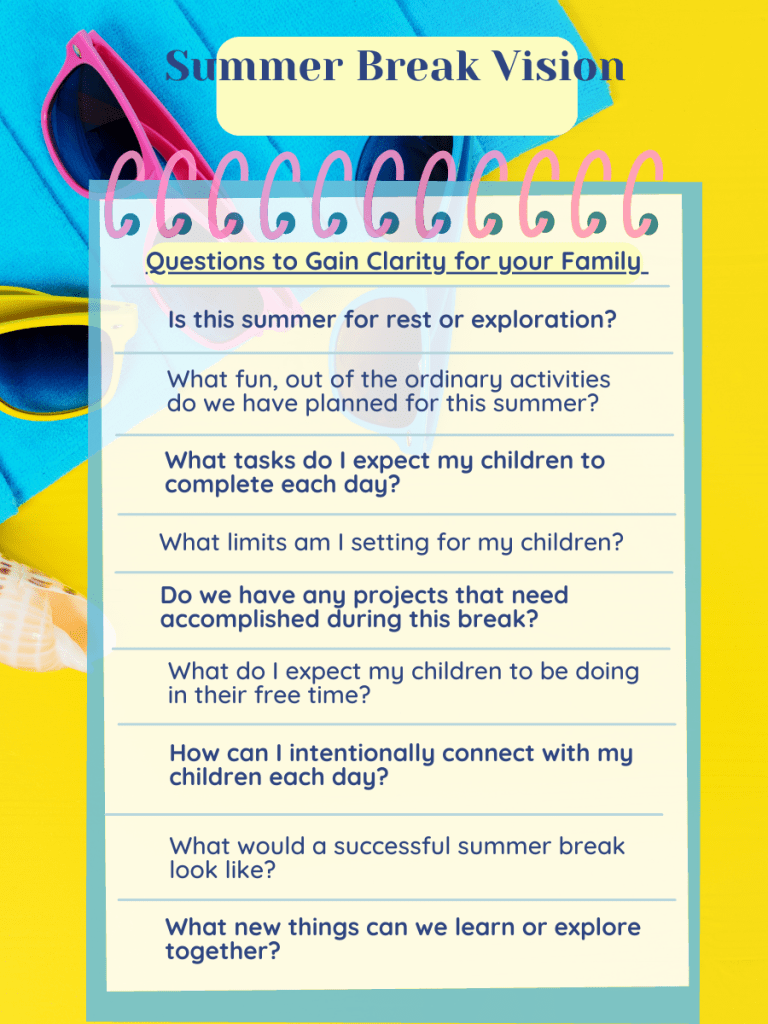Ready or not! Here summer break comes! With the kids at home full time, how can a mom create a smooth transition from school into summer break?
Transitioning from a structured, every-moment-of-the-day-is-planned-for-them environment at school to an unstructured, ever-changing summer schedule is a big change for the whole family. This article has 5 tips to help make a smooth transition into summer break and know how to respond when your child says “I’m bored.”
1. Create a Vision for Your Summer Break
The first step to a smooth transition from school into summer break, beings with the vision for your family. Having a clear vision allows us to be intentional in the decisions we make. Answering some questions about how you want your summer break to run will help you make it happen. Here are a few to guide your thinking.

2. Create your Calendar and List of Activities
Once you have a clear vision of your summer, it is now time to write it down. Use a calendar posted where everyone can see it and mark the big events on it. This helps the transition to summer break because your children can look forward to exciting events and give them a sense of purpose to their time. Marking off the days as you approach something special like a vacation trip, sleep-over, or special outing helps them feel a sense of control and confidence.
Also, brainstorming a list of all the fun activities you and your children want to do over the summer is an important part of the planning phase. Make sure to include things to do at home, day outings, or special projects you want to accomplish. Moms, make your own list of household tasks that your children can help you with. (More about this in a later tip.)
3. Set a Rhythm for your Days at Home
Decide on the flow of your day. When is screen time going to happen? Are you expecting them to get dressed? How long do they have to play independently? Having a similar time each day for screens and independent play eliminates the decision fatigue that comes with them always asking to be on a device. It takes effort and consistency to set these expectations and find your flow. However, the end product is less stress and a smooth transition from school into summer break.
4. Create a Space that Welcomes Exploration
 The key to encouraging creativity and independent play as you transition into summer break is to have your space set up to encourage exploration. Make sure you have some engaging items for them to chose from. A stack of books from the library, new sticker books, paint by number, craft kits, small Lego builds, puzzles, outdoor toys like chalk, jump ropes, or shovels are all simple things that add a lot of engagement options for your children while at home.
The key to encouraging creativity and independent play as you transition into summer break is to have your space set up to encourage exploration. Make sure you have some engaging items for them to chose from. A stack of books from the library, new sticker books, paint by number, craft kits, small Lego builds, puzzles, outdoor toys like chalk, jump ropes, or shovels are all simple things that add a lot of engagement options for your children while at home.
5. See “I’m Bored” as a Chance for Creativity
 Even with intentional planning your child will still pull the “I’m bored” card. When this happens don’t make their boredom your problem. What a child really means when they say they are bored is “I need help knowing what to do” or “I am going to bug mom as much as I can until she gives in and let’s me spend hours on my device.”
Even with intentional planning your child will still pull the “I’m bored” card. When this happens don’t make their boredom your problem. What a child really means when they say they are bored is “I need help knowing what to do” or “I am going to bug mom as much as I can until she gives in and let’s me spend hours on my device.”
Put the problem back to them by responding with “That sounds like a problem. Do you need help finding something to do?” Then use the list of fun activities at home to refer to or suggest some of the household tasks you need help with. You might be surprised when they chose to help you with some housework. Remember that boredom happens first before creativity can take hold.
In conclusion, summer break is an awesome opportunity to build relationships, have fun together, and create lasting memories. May your transition from school to summer break be smooth!



















